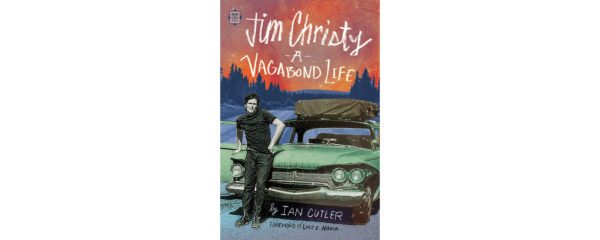
“[T]he only people for me are the mad ones, the ones who are mad to live, mad to talk, mad to be saved, desirous of everything at the same time, the ones who never yawn or say a commonplace thing, but burn, burn, burn like fabulous yellow roman candles exploding like spiders across the stars.” Those words, which Jack Kerouac famously placed in the mouth of his fictional alter-ego, Sal Paradise, in the classic novel of the Beat Generation, On the Road, might easily provide a manifesto or mission statement for anti-establishment vagabond writers in general and for American-born Canadian writer, musician, and sculptor Jim Christy in particular.
Not for nothing does biographer Ian Cutler go out of his way to point out that Christy’s first encounter with Kerouac’s novel – fished out from a mélange of books (at three for a quarter) shelved in a section of a Pennsylvania bookstore marked “SSSEX!” – comprised a kind of revelatory moment for the aspiring vagabond. “In On the Road,” Cutler writes, “Christy at last found his tribe, his family, even if a common feature of that family was to be exiled from mainstream society.”
Cutler quotes Christy himself, from a 1998 volume titled The Long Slow Death of Jack Kerouac, as saying, “I didn’t read the book so much as experience it.” Christy immediately recognized that the book was not only “important literature,” but that it also represented a map for the life of freedom from societal convention that would come to characterize his own life and work.
And what a life it has been. From a youthful flirtation with gangsterdom to a flight to Canada to escape the Vietnam War draft to work as a journalist, a film extra (he appeared as a background performer in Rocky IV), and private investigator (for a firm Christy called Extreme Research), the author has almost literally never stopped moving. All the while, he has situated himself outside any perceived ideology or political camp. Cutler locates Christy in the tradition of vagabond writers such as Kerouac and Jack London (though Christy broke with this tradition by not dying prematurely of alcoholism) and the philosophy of cynics that traces back to the Greek Diogenes. So far outside of any proscribed ideology does Christy exist that he has at various times been accused of being a “right-wing fanatic” and a “Commie dupe.”
Over the course of a literary career that has produced more than 30 volumes of fiction, autobiography, poetry, essays, and travel writing, Christy has remained staunchly apart from the literary establishment, which he often approaches with an undisguised disdain. Notwithstanding the breadth of his output, he remains the definition of a cult author in his own country: few people know his name and even fewer have read him. Those who are familiar with Christy’s writing tend to admire it, and those who admire it tend to do so with a fervent, driving passion. One of the joys of Cutler’s book is its inclusion of large swaths of Christy’s own writing (often, as Cutler himself admits, stretching the bounds of fair use). Late in the book, Christy is quoted assessing his own style: “For me, what matters is the actual sound of the words and how they all flow together – it’s music to me. I can hear it. It’s jazz.”
Readers in 2019 who are unfamiliar with Christy or unsympathetic to the author’s defiant dismissal of attitudes that have come to be characterized as politically correct might find the portrait painted here abrasive, most particularly in its espousal of a type of individualistic, pugilistic masculinity that has been challenged in recent years. And it is true that Cutler tends to give short shrift to the women in Christy’s life, especially given the fact that they seem to understand him better than most people. Cutler quotes one of Christy’s partners, artist Virginia Dixon, who provides a cogent assessment of a particularly egregious strain of masculinity: “At one end he needed total independence, at the other he needed a guardian angel.”
Dixon also outdoes Cutler in one of the book’s most piercing assessments of Christy’s artistic acumen, in this case referring to his sculptures: “Both as figure and metaphor, it is very difficult to isolate matter from spirit in a Jim Christy work. Debris is easily recognized as such but cannot remain superficial when read for its own histories. … Paradoxically, these wooden characters are not wooden at all. They are highly animated, inciting a strong desire to get up close to gaze into their glassy eyes. They want to be seen, to be read with the eyes.”
Cutler himself provides a portrait of his subject that verges on hagiography: he is largely uncritical and proves willing to accept Christy’s word about his experiences and history, regardless of how outlandish (or, in Cutler’s preferred term, “absurd”) those may be. A youthful encounter in an after-hours basement with U.S. vice-president Lyndon Johnson and a chance meeting with a Russian Count, among other tall tales, go unexamined. “I have no doubt at all about the veracity of Christy’s stories,” Cutler writes, “even if his memory for dates and chronology gets mixed up.” This attitude seems passing strange for any biographer, let alone one whose subject is so blatantly self-mythologizing.
Nevertheless, Cutler’s biography does give the uninitiated a glimpse into the life and work of a determined Canadian iconoclast, one of the country’s only authentic Beat writers, and a literary craftsperson whose work deserves a larger readership.
 Contact us via email
Contact us via email
